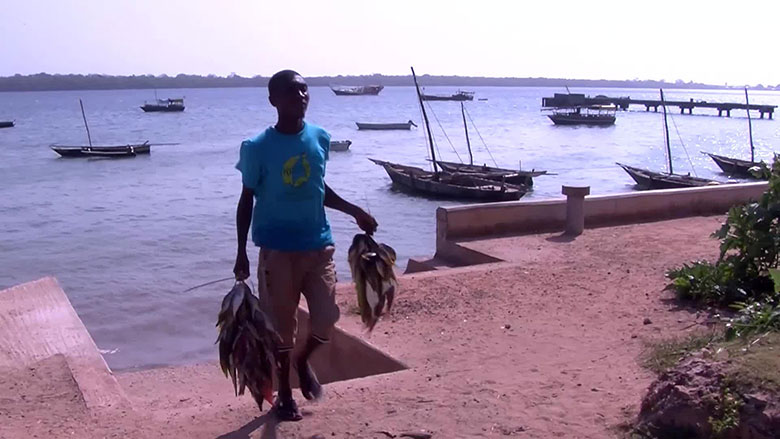NAIROBI, July 11, 2016 -- Kenya’s fisheries directly employ more than over two million people and provides nutrition to more than seven million people. Despite the many opportunities, coastal Kenya is the least developed region of the country with more than 62% living below the poverty line, and most relying on the coastal and marine ecosystem for employment, livelihood and nutrition.
Over the years, dwindling fish stocks in the nearshore waters and the recent slump in Kenya’s tourism due to insecurity, are resulting in additional coastal populations being pushed into poverty. With reduced employment opportunities and growing food insecurity, the region is becoming more fragile and more prone to conflict, especially among young people.
The Kenya Coastal Development Project, supported by the World Bank and Global Environment Facility, is helping the government at national, county and local levels take action to sustainably manage the resources and transform the livelihoods of the coastal population.
“The World Bank is delighted to be the key investor in the Kenya Coastal Development Project, and to have helped many of Kenya’s fishermen,” said Diarietou Gaye, Country Director, World Bank. “This work is ongoing and as it moves forward, it contributes to employment and food security among the communities along the coast. It is also an ingredient in the effort to build resilience against the impacts of climate change on the coastal environment and population.”
Through the project, regulatory interventions and coordination across neighboring countries and coastal counties have translated into strategic engagement with communities and long-term investments.
“We have witnessed the impact of KCDP interventions and its success in improving the management of Kenya’s coastal and marine resources, enhancing community livelihoods and generating revenue in the fisheries sector,” said Willy Bett, Cabinet Secretary, Ministry of Agriculture, Livestock and Fisheries at the launch of the documentary Community Empowerment from Ridge to Reef: The Kenya Coastal Development Project. “That is why we are pushing for a follow-up fisheries project that will fast-track benefits to target communities.”
The innovative institutional setup of KCDP has allowed government to bring key research to communities, giving them access to new aquaculture techniques and adequate tree species to plant. Specific community driven projects have been designed to fit the needs of the most vulnerable and marginalized communities and to deeply transform their lives. Waste collectors’ groups, fishermen cooperatives, women farmers, students entrepreneurs and handicapped children have each benefitted and learned how they can be at the heart of solutions against soil degradation, solid waste management, depletion of fisheries, and pollution.
“The fisheries sector and related activities are a key pillar of Kenya’s blue economy,” said Magda Lovei, Practice Manager, World Bank. “However, its long-term wealth creation depends on coastal population’s ability to keep a balance between the protection and exploitation of this valuable resource.”
Under the project, communities have become entrepreneurs through activities such as seaweed farming identified as an efficient way toward the social and economic development of coastal areas. Community enterprises such as the Kibuyuni Seaweed Farmers were connected with Seaweed East Africa Company and are now selling seaweed to China, Ireland, and Malaysia.
“The community grant program known as Hazina Ya Maendeleo ya Pwani (HMP), is one of the activities that has specially transformed lives,” said Dinesh Aryal, Senior Natural Management Specialist, World Bank. “HMP was conceptualized to provide an opportunity for the coastal communities to identify priority projects that address their immediate needs. It has been an enriching process, with 124 community projects that bring social capital, cohesion, and inclusion.”
Under the HMP Program, Vulnerable Marginalized Groups in the poorest coastal counties of Kwale, Taita Taveta, Kilifi, Tana River, Lamu and the outskirts of Mombasa are given access to basic social services to improve their living conditions. Some activities specifically focus on finding diversified opportunities to women who are the dominant force in fisheries value chains.
KCDP has laid the foundations for improved fisheries and coastal development, while enhancing the sustainable utilization of natural resources. However, much more could be done in the future to boost Kenya’s blue economy: improved governance, support to Beach Management Units, aquaculture development, better fisheries value chains and market access, up scaling of the community-driven projects under HMP, modernized fisheries infrastructure and support to artisanal and small-scale fishers to gear towards semi-industrial fisheries.
“The project interventions have extended from the terrestrial zones to the intertidal areas of the coast,” said Professor Micheni Japhet Ntiba, CBS, Principal Secretary, State Department of Fisheries and Blue Economy, MOALF. “This success was achieved through partners and multi-sectoral government agencies at different levels of government, who made sure that the project interventions achieve the desired impacts, are visible and stay sustainable. The project provides a model that can be used in implementation of other similar projects which cut across counties and aimed at bringing socio-economic development in a region.”

